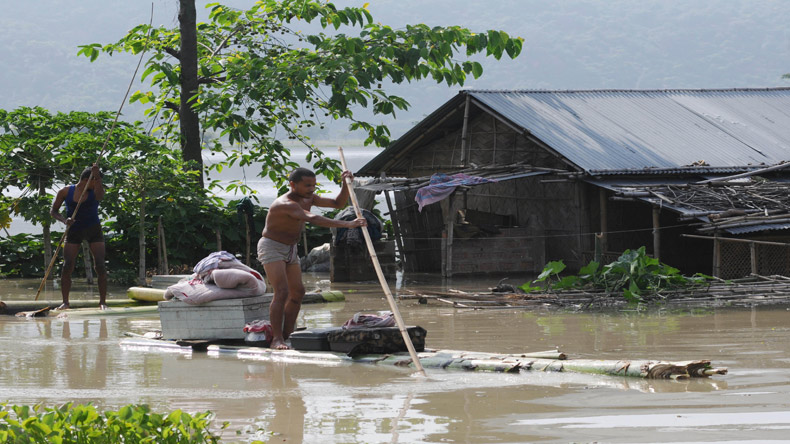Dr. Seema Javed
 Heavy monsoon rain and water from the upstream of India’s northeast have resulted in frequent floods recently, across the border in India Bangladesh, while leaving millions of people stranded and generating a humanitarian disaster.
Heavy monsoon rain and water from the upstream of India’s northeast have resulted in frequent floods recently, across the border in India Bangladesh, while leaving millions of people stranded and generating a humanitarian disaster.
Climate scientists and water management experts at home and abroad see a significant influence of climate change on this erratic behavior of rainfall and leading to record-level flooding in this area. Climate change influencing recent flood incidents. Early monsoon, marked with rainfall variability, could explain this year’s frequent flash floods, which struck Bangladesh as soon as in the first week of April, following heavy rains in months before monsoon officially kicks off in June.
Experts said there is a stronger relationship between climate change and the early monsoon that has led to flash floods. A warmer climate has influenced the weather patterns and variability, and increased rainfall and precipitation, which led to flood conditions in the middle of Himalayan regions, contributed to the current floods.

Dr. Anjal Prakash, Research Director, Adjunct Professor from Indian School of Business & IPCC author said that –“In the light of the extreme weather events across South Asia happening over the last decade or so, it can be said that there is a strong connection between climate change and early monsoon and excessive flash floods. “
Moreover, Dr. Prakash said, “Studies have shown that the Himalayan region’s rainfall patterns have been changing, leading to unpredictable weather.” For instance, India witnessed two waves of flash floods, with dozens killed in extreme rain-induced landslides and floods. He also said, “Due to climate change, a wetter climate has been predicted for this region. However, the rainfall variability means that the seasons’ rainfall may happen in 2-3 high rainfall events while the rest of the days would be a dry spell.”
Recently, at least 12 northeastern and northern districts in Bangladesh are currently reeling from a devastating flood, with major rivers such as the Brahmaputra, Jamuna, Surma, and the Kushiyara flowing above their danger marks at 18 points. The old Surma River already broke its historical water level record at Derai, flowing at 7.55 m, surpassing the previous water level record of 7.29 m, according to data provided by the Flood Forecasting and Warning Centre in Bangladesh.
On June 17, in 24 hours ending 8:30 am, Cherrapunji in Meghalaya received 972 mm of precipitation, just two days after recording 811.6 mm of rainfall in a day, Indian media reported citing the India Meteorological Department.
The wettest place in India, Mawsynram, gauged 710.6 mm of rainfall in 24 hours ending 8:30 on June 15, 2022, the highest rainfall in a day since In Bangladesh, Lourergorh in Sunamganj and Lalakhal in Sylhet have already received more rain than the average normal for this month.
Other rivers are flowing very close to their historic water levels. They are expected to set new water level records soon amid forecasts of heavy rain continuing upstream, such as in seven northeastern Indian states and West Bengal, Sikkim, Bihar, Jharkhand, and Gangetic West Bengal over the next five days.
These strong monsoon winds in the Bay of Bengal can carry a lot more moisture than ever, in response to global warming. A response to rising temperatures is the overall increase in moisture levels in the atmosphere. This is because warmer air holds more moisture, and that too for a longer time. Hence, the large amount of rainfall that we see now might be a climate change impact.
Moreover, IPCC reports have shown that the variability of rainfall is a problem as it creates skewed rainfall patterns deviating from the known characteristic of the South Asian monsoon, which is spread out rain throughout the season, which accounts for most of the year’s rain. In this regard, yProf AKM Saiful Islam from the Institute of Water and Flood Management (IWFM) of Bangladesh University of Engineering and Technology (BUET).said, “every half-degree rise matters to the world. As the IPCC mentions, this trajectory is projected to rise further unless we take immediate preparations and act now.”
The changing nature of flooding over the years ‘There been a climatic shift in monsoon patterns over South Asia since the 1950s,’ says Dr. Roxy Mathew Koll, the Lead Author of IPCC, who wrote the chapter on Indian Ocean Warming in the Climate Assessment report.
Roxy Mathew Koll, pointing out that the most significant change is that the monsoon season is now fragmented into long dry periods, broken by spells of heavy rain. For every 1-degree Celsius rise in temperatures, the total amount of rainfall will increase by 7%, up to 10% in the monsoonal region, Roxy said, adding that extreme rainfall events are projected to increase proportionally over South Asia.
Prof. Islam mentioned, “The nature of flooding has also changed over the years. Earlier this year, we witnessed early flooding before the monsoon in May. Now we are witnessing another catastrophic flooding in the north of Bangladesh.
In short succession, we have huge floods right at the beginning of the monsoon, which was not the case a few decades ago. Not only that, the total volume has increased over the years, and there Is rainfall almost six to seven times in one month. We must prepare for this unpredictable flooding.”
Usually when it rains heavily over Arunachal Pradesh and East Assam, flooding is mainly confined to Assam only. However, this time heavy rains concentrated over West Assam, Meghalaya and Tripura that inundated the Brahmaputra River. Besides landslides and flash flooding incidents in Meghalaya and Assam, the water eventually flows down to Bangladesh, adding to the flooding woes there as well.
Also Read : India can loose 184 billion USD in Stranded Asset Risk in Steel: GEM
Also Read : Cocaine in banana consignment in Czech Republic
The moisture convergence with Bay of Bengal winds has been quite high ever since the Southwest Monsoon entered Northeast India.
The abundance of moisture heated the eastern Himalayas, bringing heavy to extremely heavy rainfall during the first half of June. Similar meteorological conditions were seen during May also, which had led to flooding situations across Assam between May 11-21.
“There is this unique pattern seen this Monsoon season. In absence of any significant weather system over the core Monsoon region of West Bengal and Odisha, humid winds from Bangladesh were directly reaching up to eastern Himalayas. In a normal scenario, Northeast India records heavy spells for 5-7 days in a month, but this time it rained heavily from straight 15 days. Meghalaya recorded 3030 mm of rain in a span of just seven days from June 11-18 days,” said Dr R K Jenamani, Senior Scientist, India Meteorological Department (IMD). Every 10-12 years, there is an occurrence of excessive rainfalls. The intensity and frequency of natural disasters are rising and will further increase in the future.
We can already see excessive and untimely rainfalls in larger volumes in short time spans. Previously, we have witnessed cyclones and storm surges such as Aila, Amphan, and Cidr. In the upcoming 10-15 years, more natural disasters will hit climate-vulnerable countries such as Bangladesh, said Prof Ainun Nishat, Centre for Climate Change and Environmental Research, BRAC University.
The experts warned that this shift in seasonal characteristics will significantly impact people’s lives, livelihoods, irrigation, food and water security, and industries. Hundreds of thousands have been marooned as floods washed away houses, bridges, embankments, and other infrastructures. Moreover, at least 40 transboundary rivers carry the runoff from extreme rains upstream into Bangladesh, giving rise to floods in some of the world’s major rivers systems such as the Brahmaputra, also known as the Jamuna, the Padma, known as the Ganga in India, and the Meghna, known as the Barak in India. These rivers drain a vast catchment area of 1.72 million square kilometers spread over India, Nepal, Bhutan, China, and Bangladesh while carrying over a billion tons of silt a year.
This supply of silt often gets trapped by infrastructures built on rivers, causing its bed to rise and the rivers to overflow more than ever before. The obstruction of the natural flow of water upstream in India and China, Nepal, and Bhutan through dams and barrages, deforestation and mining in the hills, and development activities contributed to rivers downstream losing their navigability.
These reasons also made managing floods, once considered a blessing for the world’s largest delta, Bangladesh, all the more difficult. As one of the most vulnerable developing countries, Bangladesh will bear an unequal burden of such adverse impacts which will cause significant losses and damages to the country’s economy.
 Jubilee Post News & Views
Jubilee Post News & Views





